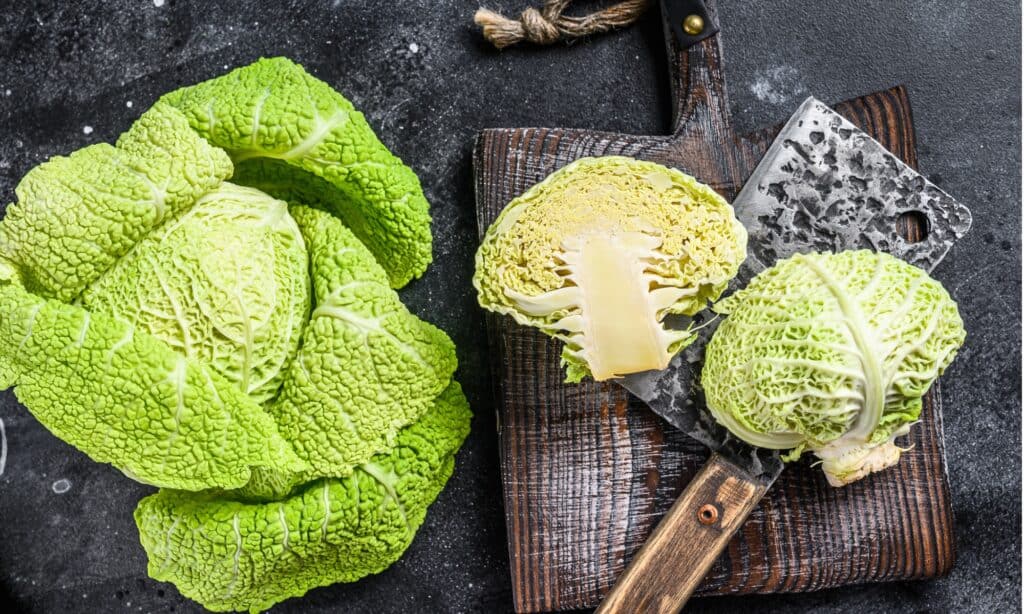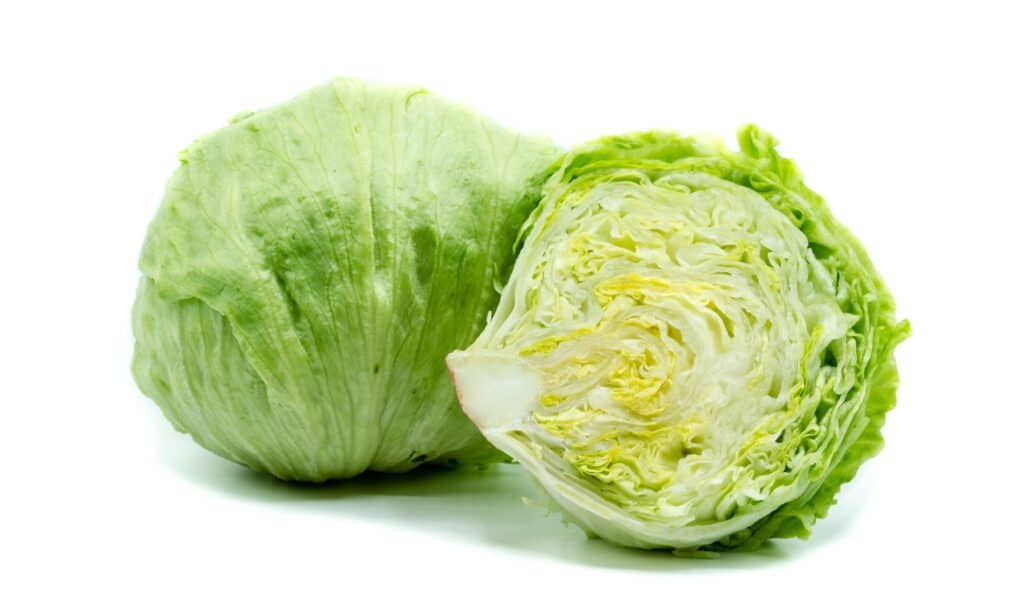While they may look strikingly similar upon first glance, there are a number of differences between iceberg lettuce vs cabbage. But what might some of these differences be, and how can you learn how to tell these two crops apart, whether you are growing them for yourself or happened to see them side by side at your local grocery store?
In this article, we will compare and contrast cabbage with iceberg lettuce so that you can understand both of these vegetables fully. We will go over what they physically look like as well as what they are typically used for, and we will even give you their nutritional information so that you can learn which one is more valuable than the other. Let’s get started now!
Comparing Iceberg Lettuce vs Cabbage

| Iceberg Lettuce | Cabbage | |
|---|---|---|
| Classification | Lactuca sativa | Brassica oleracea |
| Description | Light green head of rounded and loosely bound leaves. Texture is smooth and crisp, with white or cream leaves streaked throughout. Easy to break apart and eat, with a firm texture. | Round or oblong vegetable made up of compacted or frilly leaves, depending on the species. Dense, heavy, and ranges in color from green to red, but typically remains light in shade. Peppery and sweet, mild in flavor, and only gets sweeter as you cook it. |
| Uses | Primarily eaten raw as part of a salad or sandwich topping, but can also be grilled, sauteed, and more. Tends to wilt and turn mushy when cooked or heated, and has a bland flavor | Eaten raw, sauteed, roasted, stir fried, pickled, steamed, boiled, fermented, and more. Leaves are sturdy enough that you can wrap things in them, even after blanching |
| Nutrition Info | Includes some vitamins and minerals, but is primarily water | Full of Vitamin K and Vitamin C, as well as fiber |
| Special Features | Created in the late 1800s, iceberg lettuce is the most popular lettuce variety in the United States! | Originating in China sometime during 4000 BC, cabbage is one of the oldest vegetables known to man! |
Key Differences Between Iceberg Lettuce vs Cabbage

Iceberg lettuce is a particular variety of lettuce belonging to the Asteraceae family, while cabbage belongs to the Brassicaceae family.
©iStock.com/Vladimir Mironov
There are a number of key differences between iceberg lettuce and cabbage. For example, cabbage comes in a variety of shapes and colors, while iceberg lettuce is round and green. The texture of iceberg lettuce is smoother compared to the texture of the average head of cabbage. Finally, cabbage is more nutritionally dense compared to the average serving of iceberg lettuce.
Let’s go over all of these differences and a few others in detail now.
Iceberg Lettuce vs Cabbage: Classification
While they may look strikingly similar to one another, iceberg lettuce and cabbage belong to very different plant families and species. Iceberg lettuce is a particular variety of lettuce belonging to the Asteraceae family, while cabbage belongs to the Brassicaceae family. In more detail, iceberg lettuce is classified as Lactuca sativa, while cabbage is classified as Brassica oleracea.
Iceberg Lettuce vs Cabbage: Description

Cabbage comes in a variety of colors and shapes, while iceberg lettuce is rounded and green.
©iStock.com/Animaflora
Cabbage and iceberg lettuce look very similar to one another, especially if you are comparing green cabbage with iceberg lettuce. However, there are a few things to keep an eye out for when looking at them side-by-side, including the fact that iceberg lettuce has more white or cream colors on its leaves compared to the average head of cabbage.
Cabbage comes in a variety of colors and shapes, while iceberg lettuce is rounded and green. When it comes to flavor, cabbage has more spice and peppery flavor to its leaves compared to the relatively neutral or bland iceberg lettuce. Finally, cabbage heads are typically more compacted and dense compared to the lightweight and loosely packed leaves found with iceberg lettuce.
Iceberg Lettuce vs Cabbage: Uses

Depending on the variety of cabbage, you can steam or saute cabbage, while iceberg lettuce gets mushy when cooked.
©iStock.com/wjarek
Depending on where you live in the world, iceberg lettuce and cabbage can be used for very similar things. However, given the amount of water content found within iceberg lettuce, it is best eaten raw, while cabbage can be eaten raw or cooked with ease. In fact, depending on the variety of cabbage, you can steam or saute cabbage, while iceberg lettuce gets mushy when cooked.
Iceberg lettuce is most popularly eaten as part of a salad or on top of a sandwich or burger, while cabbage is popular as coleslaw or used as steamed cabbage wraps. Lettuce is also used as a wrap or holder, but this is only in its raw form as opposed to cooked cabbage. But are these vegetables similar to one another in terms of their nutritional value? Let’s take a closer look now!
Iceberg Lettuce vs Cabbage: Nutrition Information

The cabbage plant is a much older crop compared to iceberg lettuce.
©iStock.com/DutchScenery
No matter the variety or type, cabbage is more nutritionally dense compared to iceberg lettuce. In fact, iceberg lettuce contains more water than most other lettuce varieties, and far more water than any type of cabbage. For example, cabbage is full of vitamin K, fiber and vitamin C, while iceberg lettuce is primarily water with some vitamin and mineral content.
Iceberg Lettuce vs Cabbage: Special Features
Cabbage and lettuce are both very popular vegetables, in a variety of households and locations around the world. However, the cabbage plant is a much older crop compared to iceberg lettuce. Cabbage varieties have existed since 4000 BC, while iceberg lettuce was created in the late 1800s. In addition, iceberg lettuce is the most popular lettuce variety consumed in the United States, and it is far more popular than cabbage overall!
Up Next:
- Cabbage vs. Lettuce: 5 Key Differences
- Bibb Lettuce vs. Butter Lettuce: What Are the Differences?
- Can Dogs Eat Lettuce? It Depends on How It’s Been Prepared
The photo featured at the top of this post is © iStock.com/Animaflora
Thank you for reading! Have some feedback for us? Contact the AZ Animals editorial team.






